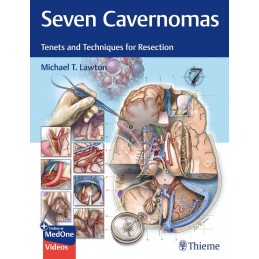- Obniżka
- Nowy


 Dostawa
Dostawa
Wybierz Paczkomat Inpost, Orlen Paczkę, DHL, DPD, Pocztę, email (dla ebooków). Kliknij po więcej
 Płatność
Płatność
Zapłać szybkim przelewem, kartą płatniczą lub za pobraniem. Kliknij po więcej szczegółów
 Zwroty
Zwroty
Jeżeli jesteś konsumentem możesz zwrócić towar w ciągu 14 dni*. Kliknij po więcej szczegółów
An incomparable collection of evidence-based cavernoma road trips through the cerebral terrain
Seven Cavernomas:: Tenets and Techniques for Resection is the fourth volume in a remarkable series by internationally renowned neurosurgeon Michael T. Lawton. As with the three prior volumes, Dr. Lawton leverages his vast expertise as a leading cerebrovascular neurosurgeon, sharing insights and knowledge gleaned from operating on over 1,400 cavernomas. Seven Cavernomas integrates quintessential clinical, anatomical, and microsurgical concepts into a comprehensive heuristic to position neurosurgeons to achieve the best patient outcomes with cavernoma microsurgical resection.
Section I details the 10 tenets of cavernoma resection, starting with a taxonomy for classification by location and surface presentation. Subsequent chapters describe brainstem and cerebral anatomy as well as dissection techniques in detail, covering the triangle concept, arterial landmarks, hotspots of brain eloquence, recurrence, patient selection, and neurosurgical cartography. Section II examines the seven types of cavernous malformations, with insightful pearls of wisdom for resection techniques. The closing chapter concludes with a discussion of the future role neurosurgery will play in understanding how the brain gives us our consciousness, emotion, memory, and intelligence.
Key Highlights
• Taxonomy of 7 cavernoma types and 35 subtypes guides the neurosurgeon to choose the optimal approaches, execute the operation skillfully, and maximize intraoperative performance
• Brainstem cavernous malformation cartography maps the special relationships among craniotomy, approach, anatomical triangles, safe entry zones, and arteries as vascular waypoints
• An impressive compendium of 65 surgical videos and 8 animations captures the action, progression, movement, and technical nuances that sculpt the art of neurosurgery
• A total of 700+ exquisitely rendered illustrations and clinical images delineate anatomical
components with stunning accuracy
This volume is an essential reference for every vascular neurosurgeon. The book demonstrates in meticulous detail how the art and science of map-making is a path to crystallizing the art and science of cavernoma resection. The taxonomy provides a consistent nomenclature for discussion while providing technical and navigational nuance, inspiring confidence, and empowering neurosurgeons to improve patient outcomes.
Opis
Indeks: 80335
Autor: Michael T. Lawton
Indeks: 32160
Autor: John T McManus
